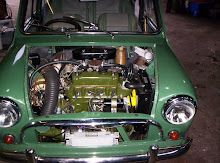The high-tension current from the coil enters the centre of the distributor cap and passes to the rotor through a spring-loaded brush—actually, a short pencil-shaped length of carbon which also acts as a suppressor to reduce the interference that would otherwise be picked up by nearby radio and television receivers. From the brass tip of the rotor the current jumps in turn to each of the terminals in the distributor cap, to which the sparking plug leads are connected in sequence to give the correct firing order 1,3,4, 2.
The brass contact on the rotor and the terminals inside the cap should be scraped bright and clean. The carbon brush should also be checked.
It does not wear away quickly but sometimes tends to stick in its guide. Do not be tempted to overstretch the spring and be careful not to break the brush.
Any accumulation of dust or oily deposits inside the cap, which will tend to attract moisture in damp weather and thus provide a leakage path for the high-tension current, should be removed with petrol and the interior surface polished with a clean cloth. If current has been leaking between the terminals, it will have left evidence in the form of dark tracks on the surface of the plastic. Sometimes these can be removed by a thorough cleaning with metal polish but bad "tracking" usually calls for renewal of the cap.
Similarly, the rotor should be thoroughly examined for signs of tracking. Occasionally internal leakage develops from the underside of the brass electrode through the plastic to the interior surface, allowing the high-tension current to jump to the cam spindle and so to earth. Needless to say, this can be a very elusive fault to spot unless one has previously experienced it.
Sunday, 11 October 2009
Distributor Rotor and Cap
Posted by Info Mini Cars at 12:00
Subscribe to:
Post Comments (Atom)


0 comments:
Post a Comment